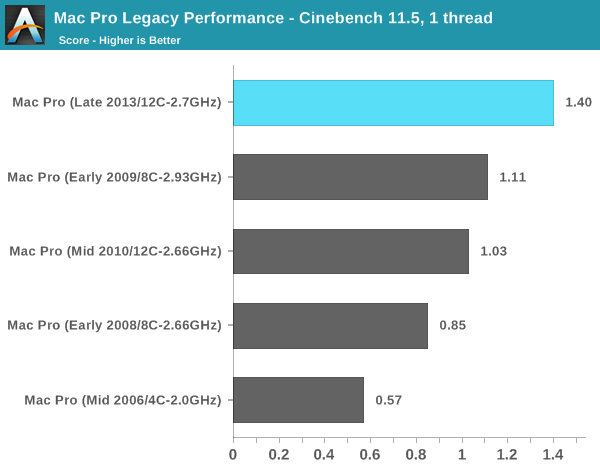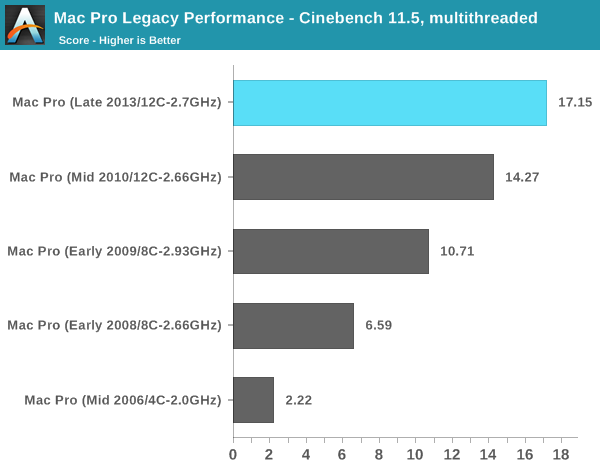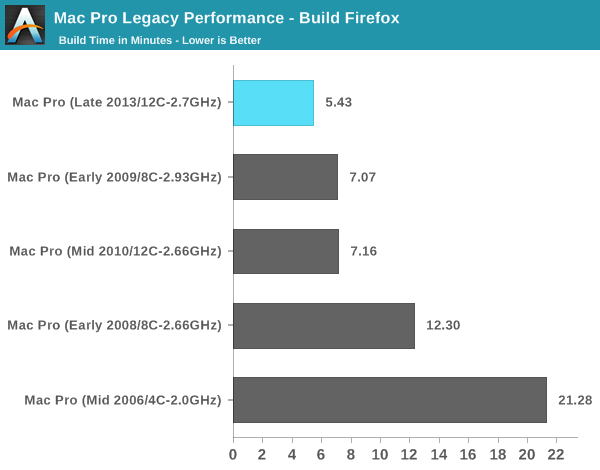The Mac Pro Review (Late 2013)
by Anand Lal Shimpi on December 31, 2013 3:18 PM ESTCPU Performance
I like to have large historical databases of performance so I can put new products in perspective. The Mac Pro and its funny lineage make this a little difficult. For starters, I simply haven't reviewed all of the Mac Pro CPU combinations that have existed over the years. Then there's also the fact that not all of my Mac suite applies well to a 12-core/24-thread Mac Pro. I'm going to try my best to put the new Mac Pro's performance in perspective, but it's going to require a couple of subsections.
Let's first start with a look at the historical performance of the Mac Pro. I really have to thank @elfurberino and @tapbot_paul for lending their time (and their Mac Pros) to help flesh out this comparison. With their help I managed to put together performance data for almost every single generation of Mac Pro.
We'll start with Cinebench R10's single threaded test. Unfortunately the benchmark crashes on Macs with 16+ threads so single threaded performance is all we'll be able to look at:

That's right, I still have my old PowerMac G5 Dual 2.5GHz (upgrade from my original 2.0 model). It's interesting to note that single threaded performance has only improved by 2.8x over that 2.5GHz dual G5 machine from around a decade ago. If we were able to also look at multithreaded performance we'd see a much larger gap. The dual G5's multithreaded performance is actually lower than the single threaded performance of the new Mac Pro's IVB-EP (3346 vs 5187). And the new Mac Pro has 12 of those cores.
Here you can see a very healthy increase in single threaded performance over the 2010/2012 12-core system. The 34% increase in performance is because the Mac Pro never got the Sandy Bridge bump. All previous Mac Pros topped out at Nehalem/Westmere. Couple all of the Sandy Bridge improvements with the much higher peak clock speeds (3.5GHz vs. 3.0GHz) and the performance gains make sense.
The 8C system from early 2009 gives us an example of how it's very possible to have a newer Mac Pro actually perform worse than its predecessor. Apple has done a relatively good job this round of keeping the core count/frequency tradeoffs sensible, but you still have to align your silicon choices to your workload.
Moving on to Cinebench 11.5, we lose the PowerMac G5 comparison but we gain a more modern benchmark. Once again we'll start with the single threaded numbers:

There's that healthy single threaded performance bump again. It is pretty incredible to me just how far we've come in single threaded performance since the mid-2000s. What's even crazier is that 2.0GHz Mac Pro from 2006 is only about 40% faster than a Bay Trail tablet with an Atom Z3770.

The multithreaded story is more evolutionary for sure, especially compared to the previous generation 12-core model. Here we're showing a 20% gain over the previous 12-core design. If you're migrating from a machine with fewer cores you can expect a corresponding increase in multithreaded performance. What is most surprising here is that a 2.3GHz 15-inch MacBook Pro with Retina Display (Late 2013) actually offers better multithreaded performance than the 8-core 2.66GHz Mac Pro from early 2008 in the chart above. The new 15-inch rMBP scores a 6.62 here compared to the 6.58 of that old Mac Pro.
I also shared my Firefox build test with Adam and Paul, who helped me fill out the chart below:

There isn't much of an advantage to having 12 cores here, but the new Mac Pro does deliver an amazingly quick build time compared to anything else. The new Mac Pro is good for around a 24% improvement in build performance compared to the outgoing 12-core model.










267 Comments
View All Comments
Dandu - Friday, January 10, 2014 - link
Hi,It's possible to use a 2 560 x 1 440 HiDPI definition, with a NVIDIA card, a 4K Display and the (next) version of SwitchResX.
I have tested that : http://www.journaldulapin.com/2014/01/10/ultra-144...
Haravikk - Sunday, January 12, 2014 - link
The news about the USB3 ports is a bit strange, doesn't that mean a maximum throughput of 4gbps? I know most USB3 storage devices will struggle to push past 500mb/sec, but that seems pretty badly constrained. Granted, Thunderbolt is the interface that any storage *should* be using, but the choices are still pretty poor for the prices you're paying, and no-one offers Thunderbolt to USB3 cables (only insanely priced hubs with external power).Otherwise the review is great, though it'd be nice to see more on the actual capabilities of Apple's FirePro cards. Specifically, how many of the FirePro specific features do they have such as 30-bit colour output, EDC, ECC cache memory, order-independent-transparency (under OpenGL) and so-on? I'm assuming they do given that they're using the FirePro name, but we really need someone to cover it in-depth to finally put to rest claims that consumer cards would be better ;)
eodeot - Monday, February 24, 2014 - link
I'd love a realistic comparison with an i7 4770k and say, 780ti.You also compare 12 cored version to older 12 core versions that hide behind (fairly) anonymous xeon labeling that hide their chip age (sandy/ ivy bridge/haswell...). I'd like to see in how any real world applications does a 12 core chip perform faster. Excluding 3d work and select video rendering, I doubt there is much need to extra cores. You note how its nice to have buffer of free cores for everyday use, while heavy rendering- but I never noticed a single hiccup or a slowdown with 3d rendering on my i7 4770k with all 8 logical cores taxed to their max. How much of better performance then "butter smooth" one already provided with a much cheaper CPU can you get?
Also you compare non apple computers with same ridiculous CPU/GPU combinations. Who in their right mind would choose a 4core Xeon chip over a haswell i7? The same goes for silly "workstation" GPU over say a Titan. Excluding dated opengl 3d apps, no true modern workstation benefits from a "workstation" GPU, if we exclude select CUDA based 3d renderers like iray and vray rt that can benefit from 12gb of ram. GPUs included with Apple Mac pro have 2gb... Not a single valid reason a sane person would buy such a card. Not one.
Also, you point out how gaming makes the most sense on windows, but do no such recommendation for 3d work. Like games, 3d programs perform significantly better under directX and that leaves windows as a sole option for any serious 3d work...
I found this review interesting for design Apple took, but everything else appears one sided praise...
pls.edu.yourself - Wednesday, February 26, 2014 - link
QUOTE: "The shared heatsink makes a lot of sense once you consider how Apple handles dividing compute/display workloads among all three processors (more on this later)."Can anyone help point me to this. I think one of my GPU's is not being used.
PiMatrix - Saturday, March 8, 2014 - link
Apple Fixed the HiDPI issue on Sharp K321 in OS 10.9.3. Works great. Supported HiDPI resolutions are the native 3840x2160, and HiDPI: 3200x1800, 2560x1440, 1920x1080, and 1280x720. You can also define more resolutions with QuickResX but the above seem to be enough. Using 3200 x1800 looks fantastic on this 4K display. Great job Apple!le_jean - Monday, March 10, 2014 - link
Any information on updated 60Hz compatibility concerning Dell's UP 2414Q in 10.9.3?I would be very interested to get some feedback in relation to:
nMP & Dell UP 2414Q
rMBP & Dell UP 2414Q
I remember in anandtech review of late 2013 nMP there have been issues concerning that specific display, while Sharp and ASUS performed just fine
philipus - Monday, April 14, 2014 - link
As a happy photo amateur, I have to say the previous Mac Pro is good enough for me. I have the early 2008 version which I like because of its expandability. Over the years I have added drives, RAM and most recently a Sonnet Tempo Pro with two Intel 520 in order to get a faster system. As cool and powerful as the new Mac Pro is, it would cost me quite a lot to add Thunderbolt boxes for the drives I currently use, so it is not worth it for me.I do agree that it is about time a manufacturer of desktop computers pushed the platform envelope. It's been tediously samey for a very long time. I'm not surprised it was Apple that made the move - it's in Apple's DNA to be unexpected design-wise. But as much as it is nice to see a radical re-design of the concept of the desktop computer, I think a future version of the Mac Pro needs to be a bit more flexible and allow more user-based changes to the hardware. Even if I could afford the new Mac Pro - and I would also place it on my desktop because it's really pretty - I wouldn't want to have several Thunderbolt boxes milling around with cables variously criss-crossing and dangling from my desk.
walter555999 - Saturday, June 7, 2014 - link
Dear Anand, could you post how to connect a up2414Q to macbook pro retina (2013) ? I have tried a cable mini display port-HDMI. But there are no image in the dell monitor. Thank you very much. WalterFasarinen - Saturday, August 9, 2014 - link
Thanks for an excellent review. (And hello, everybody; this is my first post on this site.)I noticed, in the "GPU choices" section, what seems to be a very useful utility for monitoring the GPU. The title on the top of the screen is "OpenCL Driver Monitor"; the individual windows (which are displaying graphs of GPU utilisation) seem to be titled "AMDRadeonXL4000OpenCLDriver".
I'm probably just being dim, but a bit of googling doesn't shed much light. If anybody could point to me to where this utility can be obtained from, I'd be most grateful.
Thanks ....
pen-helm - Friday, September 12, 2014 - link
I showed this page to a Mac user. They replied:I'm pretty sure that this simple fix takes care of the issue with
monitors where OS X doesn't offer a HiDPI mode:
http://cocoamanifest.net/articles/2013/01/turn-on-...